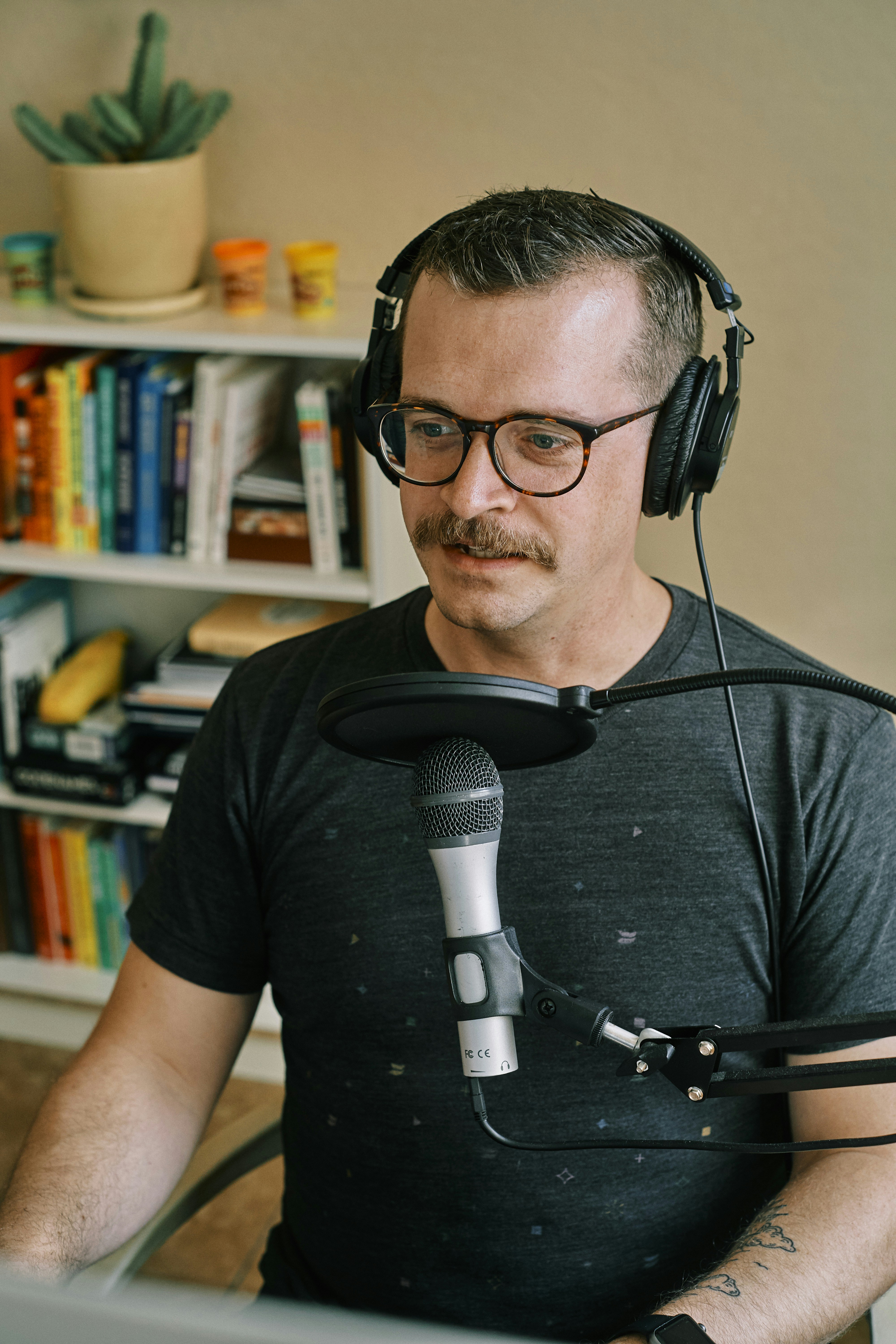Are you tired of your podcast episodes being littered with unwanted pops and plosives? Look no further than advanced pop filters! In this article, we’ll take a deep dive into the world of advanced pop filters and how they can enhance the quality of your recordings. From recommended brands to essential podcasting equipment, we’ll cover everything you need to know to take your podcast to the next level. So, get ready to say goodbye to those pesky pops and say hello to professional-grade audio with advanced pop filters.
Different Types of Pop Filters
When it comes to recording audio, using a pop filter is essential to ensure a clean and professional sound. Pop filters are specifically designed to reduce the impact of plosive sounds, such as “p” and “b” sounds, which can cause distortion and unwanted noise in recordings. There are various types of pop filters available on the market, each with its own unique advantages. Let’s take a closer look at the three main types of pop filters: nylon mesh pop filters, metal mesh pop filters, and foam pop filters.
Nylon Mesh Pop Filters
Nylon mesh pop filters are a popular choice among recording enthusiasts and professionals alike. These filters consist of a fine nylon mesh stretched across a circular frame and are designed to effectively diffuse airflow from the vocalist’s mouth when speaking or singing into a microphone. Nylon mesh pop filters are known for their ability to minimize plosive sounds while preserving the clarity of the vocals. They are also durable and easy to clean, making them a practical choice for long-term use.
Metal Mesh Pop Filters
Metal mesh pop filters, as the name suggests, are made from a fine metal mesh material. These filters are known for their superior durability and longevity. Metal mesh pop filters effectively diminish plosive sounds and offer excellent protection for your microphone against potential damage. Metal mesh filters are often preferred for their transparent sound quality and their ability to handle high sound pressure levels. They are a popular choice among professionals in recording studios and broadcast environments.
Foam Pop Filters
Foam pop filters, also known as windshields, are made from a dense foam material that helps to reduce plosive sounds and minimize unwanted background noise. These filters are highly effective in attenuating wind noise, making them an ideal choice for outdoor recordings or in environments with significant air movement. Foam pop filters are lightweight and portable, making them a convenient option for on-the-go recording. They are also the most affordable type of pop filter, making them a popular choice for beginners or those on a tight budget.
Benefits of Advanced Pop Filters
Using an advanced pop filter can greatly enhance the quality of your recordings. These pop filters are specifically designed to provide superior performance and offer a range of benefits that can take your audio productions to the next level.
Improved Clarity
One of the key benefits of using an advanced pop filter is improved clarity in your recordings. By reducing plosive sounds and minimizing unwanted noise, a high-quality pop filter allows your vocals or voiceovers to shine through with exceptional clarity. This is especially important in professional settings such as podcasting, broadcasting, and vocal recording, where crystal-clear audio is essential.
Reduced Plosive Sounds
Advanced pop filters are specifically engineered to effectively reduce plosive sounds, which are caused by bursts of air hitting the microphone diaphragm. These sounds can range from subtle distortions to loud popping noises, all of which can significantly degrade the quality of your recordings. An advanced pop filter acts as a barrier between the vocalist and the microphone, diffusing airflow and minimizing the impact of plosive sounds, resulting in cleaner and more professional audio.
Enhanced Vocal Performance
An advanced pop filter can greatly enhance vocal performance. By reducing plosive sounds and improving clarity, these filters allow the vocalist to focus on their delivery without the worry of distracting pops or distortion. The smoother and more even sound provided by a high-quality pop filter can boost the confidence of the performer and result in a more natural and engaging vocal performance.
Key Features to Look for in Advanced Pop Filters
When choosing an advanced pop filter, there are several key features to consider. These features can greatly affect the performance and versatility of the filter, ensuring that you get the best possible results for your specific recording needs.
Double Layer Design
One important feature to look for in an advanced pop filter is a double layer design. This design consists of two layers of filtering material, typically mesh or foam, which work together to provide enhanced plosive reduction. The double layer design effectively disperses airflow and reduces the impact of plosive sounds, resulting in cleaner recordings with improved clarity.
Adjustable Gooseneck
An adjustable gooseneck is another valuable feature in an advanced pop filter. This flexible arm allows you to position the filter at the optimal distance and angle from the microphone to achieve the best possible sound quality. The ability to adjust the gooseneck ensures that you can easily position the pop filter according to your specific recording setup and the vocalist’s needs.
Sturdy Clamp
A sturdy clamp is an essential feature to look for in an advanced pop filter. The clamp securely attaches the filter to a microphone stand or boom arm, ensuring stability and preventing unwanted movement during recording sessions. A well-built clamp should be easy to tighten and release, allowing for quick and secure attachment to various microphone setups.
Universal Compatibility
When choosing an advanced pop filter, it’s important to ensure that it is compatible with a wide range of microphone sizes and types. Look for a filter that offers universal compatibility, allowing you to use it with condenser microphones, dynamic microphones, and ribbon microphones. A pop filter with universal compatibility ensures versatility and allows you to use it with different microphones as your recording needs evolve.
Best Advanced Pop Filters on the Market
Now that we have explored the benefits and key features of advanced pop filters, let’s take a look at some of the top options available on the market. These pop filters have consistently received positive reviews for their performance, durability, and value for money.
Stedman Proscreen XL
The Stedman Proscreen XL is a highly acclaimed advanced pop filter that offers exceptional performance and durability. Featuring a double layer design with a metal mesh and a foam layer, this filter effectively reduces plosive sounds while preserving the clarity of the vocals. The adjustable gooseneck and sturdy clamp ensure easy positioning and secure attachment to a wide range of microphone setups. The Stedman Proscreen XL is compatible with various microphone sizes and has received rave reviews from professionals in the recording industry.
Nady MPF-6
The Nady MPF-6 is a reliable and affordable advanced pop filter that offers excellent performance and value for money. This filter features a double layer nylon mesh design that effectively reduces plosive sounds and unwanted noise. The adjustable gooseneck allows for easy positioning, and the sturdy clamp ensures secure attachment to microphone stands or boom arms. The Nady MPF-6 is widely compatible with different microphone sizes and types, making it a versatile choice for various recording applications.
Aokeo Professional Microphone Pop Filter
The Aokeo Professional Microphone Pop Filter is a budget-friendly option that delivers impressive performance and durability. With a double layer nylon mesh design and an adjustable gooseneck, this filter effectively reduces plosive sounds and allows for easy positioning. The sturdy clamp securely attaches the filter to microphone stands or boom arms, ensuring stability during recording sessions. The Aokeo Professional Microphone Pop Filter is compatible with a wide range of microphones, making it a versatile and cost-effective choice for both beginners and professionals.
Comparison of Top Advanced Pop Filters
When choosing the right advanced pop filter for your needs, it’s essential to compare key factors such as price, material, and design. Let’s compare these aspects for the top advanced pop filters mentioned above.
Price
In terms of price, the Stedman Proscreen XL is considered a higher-end option, retailing at a slightly higher price point. The Nady MPF-6 is mid-range in terms of price, offering a balance between performance and affordability. The Aokeo Professional Microphone Pop Filter is the most budget-friendly option, making it an ideal choice for those on a tight budget.
Material
The Stedman Proscreen XL features a dual-layer design with a metal mesh and foam layer. The Nady MPF-6 and the Aokeo Professional Microphone Pop Filter both have a double layer nylon mesh design. While both materials effectively reduce plosive sounds, the metal mesh offers superior durability and longevity compared to the nylon mesh.
Design
In terms of design, all three pop filters mentioned above feature an adjustable gooseneck and a sturdy clamp. This allows for easy positioning and secure attachment to various microphone setups. The Stedman Proscreen XL and the Nady MPF-6 offer universal compatibility with a wide range of microphone sizes and types, while the Aokeo Professional Microphone Pop Filter is also compatible but may have limitations with specific microphone sizes.
How to Choose the Right Advanced Pop Filter for Your Needs
Choosing the right advanced pop filter for your needs involves considering several important factors. By taking these factors into account, you can ensure that you select a pop filter that is compatible with your recording environment, fits your budget, and meets your specific requirements.
Consider Your Recording Environment
Before selecting an advanced pop filter, consider the type of recording environment you will be working in. If you primarily record in a controlled studio setting, any of the mentioned pop filters will work effectively. However, if you often record outdoors or in environments with significant air movement, a foam pop filter may be the best choice due to its ability to attenuate wind noise effectively.
Evaluate Your Budget
Another crucial factor to consider when choosing an advanced pop filter is your budget. Determine how much you are willing to spend and look for filters within that price range. Remember that the price of a pop filter is often reflective of its materials, durability, and overall performance. If you have a higher budget, investing in a higher-end option such as the Stedman Proscreen XL may be worth considering for its exceptional performance and longevity. However, if you are on a tight budget, the Nady MPF-6 or the Aokeo Professional Microphone Pop Filter offer reliable performance at an affordable price point.
Check Compatibility
Ensure that the advanced pop filter you choose is compatible with your specific microphone setup. While the Stedman Proscreen XL and the Nady MPF-6 offer universal compatibility, it is still advisable to check the specifications and dimensions of your microphone to ensure a proper fit. The Aokeo Professional Microphone Pop Filter is also compatible with various microphone sizes, but it may not fit certain larger or uniquely shaped microphones.
Proper Placement and Usage of Advanced Pop Filters
Knowing how to properly position and use your advanced pop filter is crucial for achieving optimal results. Follow these guidelines to ensure the effective use of your pop filter:
Positioning the Pop Filter
Position your pop filter between yourself and the microphone, ensuring that it covers the entire area where plosive sounds are most likely to occur. The filter should be placed approximately two to three inches away from the microphone diaphragm.
Distance and Angle
Maintain a proper distance between your mouth and the pop filter to minimize the impact of plosive sounds. Ideally, position the filter at the same distance as your microphone, ensuring the most effective reduction of plosive sounds while maintaining good vocal levels. Additionally, position the pop filter at a slight angle, tilted slightly downward to maximize its effectiveness.
Cleaning and Maintenance
Regularly clean and maintain your advanced pop filter to ensure optimal performance and longevity. Nylon mesh and metal mesh pop filters can be gently cleaned with mild soap and water, while foam pop filters can be washed and air-dried. Ensure that the filter is completely dry before using it again.
Common Mistakes to Avoid When Using Advanced Pop Filters
While using an advanced pop filter can greatly improve the quality of your recordings, it’s important to be aware of common mistakes that can compromise its effectiveness. Avoid these mistakes to ensure optimal performance:
Incorrect Distance Between Mouth and Pop Filter
Maintaining the correct distance between your mouth and the pop filter is crucial. Placing your mouth too close to the filter or too far away can impact its ability to effectively reduce plosive sounds. Experiment with different distances to find the optimal position for your specific voice and recording setup.
Over tightening the Clamp
When attaching the pop filter to a microphone stand or boom arm, avoid over tightening the clamp. Over tightening can deform the filter or damage the attachment mechanism, resulting in poor stability and potential breakage. Tighten the clamp securely, but ensure it is not overly tightened to prevent any damage to the filter or equipment.
Neglecting Regular Cleaning
Regular cleaning and maintenance of your pop filter is vital to ensure its longevity and performance. Neglecting to clean the filter regularly can lead to the accumulation of dirt, dust, and debris, which can affect its ability to effectively reduce plosive sounds. Follow the manufacturer’s cleaning instructions and establish a regular cleaning routine to maximize the lifespan and performance of your pop filter.

Tips for Maximizing the Effectiveness of Advanced Pop Filters
While using an advanced pop filter is an excellent step towards achieving cleaner and more professional audio recordings, there are additional techniques that can further enhance its effectiveness. Consider these tips to maximize the impact of your pop filter:
Using Proper Microphone Technique
In addition to using a pop filter, employing proper microphone technique is crucial for achieving the best possible sound quality. Ensure that you speak or sing directly into the microphone, maintaining a consistent distance and angle. Avoid excessive movements or touching the pop filter during recording to minimize unwanted noise.
Using Additional Vocal Techniques
In some cases, certain vocal techniques can help minimize plosive sounds. Experiment with techniques such as angling your head slightly away from the microphone when pronouncing “p” and “b” sounds, or using a slightly softer and more controlled vocal delivery. These techniques, combined with an advanced pop filter, can further reduce the impact of plosive sounds and enhance the overall clarity of your vocals.
Working on a Proper Microphone Setup
Creating a proper microphone setup can significantly improve the effectiveness of your pop filter. Ensure that your microphone is correctly positioned and set up according to the manufacturer’s instructions. Consider using a microphone shock mount or a boom arm to further isolate the microphone from vibrations and unwanted noise. A well-optimized microphone setup, complemented by a high-quality pop filter, can result in professional-level audio recordings.
Conclusion
Advanced pop filters are a crucial tool for any recording enthusiast or professional seeking to produce clean and professional audio. With their ability to reduce plosive sounds and improve clarity, these filters play a vital role in achieving high-quality recordings. When choosing an advanced pop filter, consider the specific features that best fit your needs, such as a double layer design, an adjustable gooseneck, a sturdy clamp, and universal compatibility. By following the proper placement and usage guidelines, avoiding common mistakes, and employing additional techniques, you can maximize the effectiveness of your pop filter and elevate the quality of your recordings. Choose an advanced pop filter that suits your recording environment, evaluate your budget, and ensure compatibility with your microphone setup. With the right pop filter in place, you can enjoy cleaner, crisper, and more professional audio recordings.



